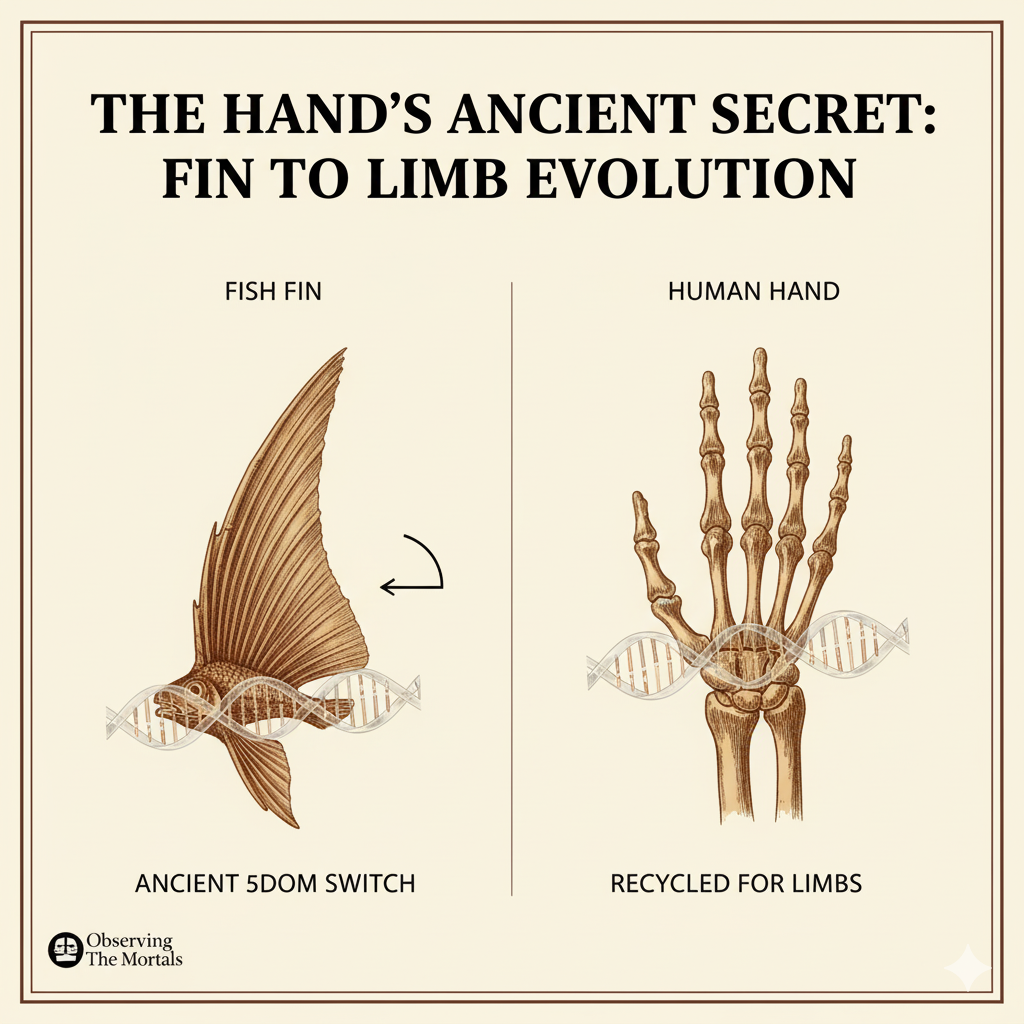The human hand is a marvel of evolutionary engineering. It can wield a hammer, create art, and express love. For centuries, scientists have tried to answer a fundamental question: how did this intricate structure evolve from the humble fin of our fishy ancestors who first crawled onto land 360 million years ago? A groundbreaking new study, powered by CRISPR gene-editing technology, provides a stunning answer. It overturns the old idea that new body parts require new genes, revealing instead a more elegant story of evolution as a clever tinkerer, “cobbling together” ancient genetic parts for revolutionary new purposes.
The Information Box
Syllabus Connection:
- Paper 1: Chapter 9.4 (Human DNA profiling, gene mapping and genome study), Chapter 1.4 (Principles of Evolution; Primate Adaptations), Chapter 9.1 (Human Genetics).
Key Concepts/Tags:
- Evolution, Fins-to-Limbs Transition, CRISPR, 5DOM, Gene Regulation, Deep Homology
The Setting: Who, What, Where?
This case study is based on a recent study published in the prestigious journal Nature, with key research conducted by scientists like Aurélie Hintermann at the Stowers Institute for Medical Research. The researchers used the powerful CRISPR gene-editing tool on the embryos of zebrafish, a small freshwater fish that serves as a powerful model organism for studying genetics and development. By studying the genetics of fin development in a modern fish, they were able to unlock a deep evolutionary secret shared by all land vertebrates, including humans.
The Core Argument: Why This Study Matters
This research fundamentally reshapes our understanding of how major evolutionary innovations happen at the genetic level.
- Evolution as a “Tinkerer,” Not an Engineer: The study’s central argument is that evolution often works by repurposing existing genetic tools rather than inventing entirely new ones from scratch. The old idea was that to build something new like a hand, you need new “hand genes.” This research proves that instead, nature “cobbled together” the ancient genetic program used for building fins, redeploying it in a new way to construct limbs.
- “5DOM” – The Ancient Genetic Switch: The key discovery is a specific stretch of DNA called the 5DOM region. This is not a gene that makes a protein, but a regulatory switch—a genetic “key” that turns on a whole suite of other genes. The researchers found this exact same 5DOM switch controls the development of the fin region in zebrafish and the hands/feet region in mammals.
- The CRISPR Proof: The scientists provided definitive proof using CRISPR. When they precisely deleted the 5DOM region from the DNA of zebrafish embryos, the fish failed to develop their fins properly. This demonstrated that 5DOM is an ancient and essential piece of genetic machinery for building appendages, a role it has maintained for over 400 million years from fish to humans.
The Anthropologist’s Gaze: A Critical Perspective
- A Window into “Deep Homology”: This finding is a powerful example of a concept called deep homology. This is the idea that vastly different structures in different species (like the fin of a fish and the hand of a human) are controlled by the same, deeply ancient, shared genetic regulatory networks. It’s a profound reminder of the interconnectedness of all life and the efficiency of the evolutionary process.
- A Piece of a Larger Puzzle: A critical perspective would note that this discovery, while monumental, is one piece of a much larger puzzle. The 5DOM switch is like the master “on” button for making an appendage, but it doesn’t explain the entire complex developmental cascade that specifies the unique form of a human hand (five fingers, an opposable thumb, etc.). It’s the starter, but not the full blueprint.
- From Macroevolution to Micro-level Understanding: This case study is a perfect example of a major trend in modern physical anthropology: the move from studying evolution purely through the fossil record (macro-level) to understanding its precise mechanisms at the genetic and molecular level (micro-level).
The Exam Angle: How to Use This in Your Mains Answer
- Types of Questions Where It Can be Used:
- “Discuss the principles of evolution with recent scientific evidence.”
- “What is the role and significance of modern genetic techniques in the study of human evolution?”
- GS-3 (Science & Tech): “Explain the application of CRISPR technology beyond therapeutics.”
- Model Integration:
- On the Principles of Evolution: “Evolution often acts as a ‘tinkerer,’ repurposing existing genetic material rather than creating new genes for new functions. A powerful recent example is the discovery of the ‘5DOM’ genetic switch, which shows that the same ancient genetic program used to build fish fins was recycled to build the hands and feet of land animals.”
- On Modern Genetic Techniques: “Modern techniques like CRISPR are revolutionizing our understanding of evolutionary history. For instance, a recent study used CRISPR to delete the 5DOM gene region in zebrafish, proving its essential role in fin development and confirming its shared ancestry with the genetic program that builds human limbs.”
- For a GS-3 Answer: “Beyond its therapeutic potential, gene-editing technology like CRISPR is a crucial tool for fundamental research. It is being used to answer long-standing evolutionary questions, such as a recent study that used CRISPR to provide a genetic explanation for how our ancient fish ancestors evolved limbs to walk on land.”
Observer’s Take
The story of our own hands is written deep within our DNA, but this research reveals it’s a far more ancient and intricate epic than we ever imagined. It shows the beautiful, thrifty logic of evolution: nature doesn’t always invent from scratch; it brilliantly re-invents. To think that the same genetic “on” switch that guides the formation of a fish’s fin also orchestrates the development of the hands that would eventually paint on cave walls, write poetry, and build civilizations is a profound testament to our deep connection to the entire web of life. It’s a powerful reminder that we still carry the echoes of the sea in our very genes.





